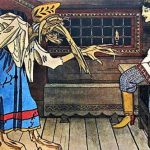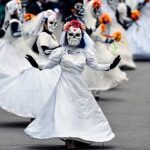 Technology
Technology  Technology
Technology  Our World
Our World 10 Ways Icelandic Culture Makes Other Countries Look Boring
 Misconceptions
Misconceptions 10 Common Misconceptions About the Victorian Era
 Mysteries
Mysteries 10 Strange Unexplained Mysteries of 2025
 Miscellaneous
Miscellaneous 10 of History’s Most Bell-Ringing Finishing Moves
 History
History 10 Great Escapes That Ended Right Back in Captivity
 Weird Stuff
Weird Stuff 10 Fascinating Things You Might Not Know About Spiders
 Food
Food 10 Everyday Foods You Didn’t Know Were Invented by the U.S. Military
 History
History 10 Odd Things Colonial Americans Kept at Home
 Weird Stuff
Weird Stuff 10 Superstitious Beliefs That Once Consumed Entire Cultures
 Technology
Technology 10 Scientific Breakthroughs of 2025 That’ll Change Everything
 Our World
Our World 10 Ways Icelandic Culture Makes Other Countries Look Boring
 Misconceptions
Misconceptions 10 Common Misconceptions About the Victorian Era
Who's Behind Listverse?

Jamie Frater
Head Editor
Jamie founded Listverse due to an insatiable desire to share fascinating, obscure, and bizarre facts. He has been a guest speaker on numerous national radio and television stations and is a five time published author.
More About Us Mysteries
Mysteries 10 Strange Unexplained Mysteries of 2025
 Miscellaneous
Miscellaneous 10 of History’s Most Bell-Ringing Finishing Moves
 History
History 10 Great Escapes That Ended Right Back in Captivity
 Weird Stuff
Weird Stuff 10 Fascinating Things You Might Not Know About Spiders
 Food
Food 10 Everyday Foods You Didn’t Know Were Invented by the U.S. Military
 History
History 10 Odd Things Colonial Americans Kept at Home
 Weird Stuff
Weird Stuff 10 Superstitious Beliefs That Once Consumed Entire Cultures
10 Representations of Death from Myth, Legend, and Folktale
Death is one of humanity’s oldest mysteries—universal, inevitable, and endlessly interpreted. Across time and culture, people have tried to make sense of what comes next by giving death a name, a face, or even a personality. Sometimes it’s a cloaked skeleton with a scythe, sometimes a beautiful queen ruling a frozen underworld, and sometimes a mischievous spirit reminding us to live while we still can.
These figures do more than personify our fears; they guide, judge, protect, and even celebrate life’s final passage. From the gods of ancient myth to the ghosts of Celtic legend and the saints of modern faith, here are ten unforgettable representations of death from around the world—each one revealing how humans have learned to stare into the darkness and give it meaning.
Related: 10 Mythical Humanoids from the Ancient World
10 The Grim Reaper – Death’s Tireless Harvester
European folklore brought to life one of the most famous death mascots in the world: the Grim Reaper. A cultural and mythological figure, the Reaper is often depicted as a skeleton in a long, flowing, hooded black cloak that perfectly encapsulates the dark and mysterious essence of death. In his hand is the large, iconic scythe, which he uses to “harvest” souls from the Earth, the same way farmers reap or harvest crops that are ripe and ready to be plucked.
The Grim Reaper works tirelessly, reaping one soul after another with the eerie grace of a shadow or ghost. The last thing his victims see is the bare bones and hollow, black eye sockets of his skull resting just beneath his hood.
The legend of the Grim Reaper emerged in the late Middle Ages. It became especially prominent during the Black Death—a catastrophic plague that ravaged Europe between 1347 and 1351, killing an estimated one-third of the population. Born from an era of fear and death, the Reaper endures as a symbol of mortality and the inescapable reality of the human condition.[1]
9 Hel – The Half-Dead Queen of the Norse Underworld
From Norse mythology comes Hel, who rules as the “Queen of the Dead” within her dark realm. Hel is the daughter of the trickster god Loki and the giantess Angrboda. Her brothers are Fenrir, the Wolf, and Jörmungandr, the World Serpent. Unlike her brothers, Hel is depicted as half a beautiful woman and half a decaying corpse—her dual nature mirroring life and death itself.
Hel’s realm, Helheim, is bleak and misty. While others are destined for punishment or glory, Helheim is meant to house those who died of old age or sickness. The souls there are treated decently but live in a dreary stillness. The phrase “gone to Hel” captures the damp, cold, and joyless atmosphere of her domain.
Hel represents the quiet, unannounced death—the kind that comes in a blink—and serves as a reminder to make the most of life before the final darkness.[2]
8 Baron Samedi – Vodou’s Party-Loving Lord of the Dead
Baron Samedi is one of the most well-known lwa within Haitian Vodou. As “chief spirit of the dead” and “guardian of the veil between life and death,” he is charged with welcoming new souls to the underworld and deciding who lives and who dies. With the power to heal any mortal ailment or break any curse, he can protect the living—if he deems them worth saving.
The Baron is depicted with a skull-like face and a long black tailcoat, topped with a matching hat and dark sunglasses (one lens removed so he can keep an eye on the living). A cigar in one hand and a glass of his signature spiced rum in the other, he sometimes wears cotton plugs in his nostrils, as if preparing a corpse for burial.
Playful, mischievous, and delightfully irreverent, Baron Samedi enjoys food, drink, and sensual pleasures. He reminds mortals not to take life too seriously, offering a comforting message that death is not to be feared—but embraced as part of life’s grand celebration.[3]
7 Yama – The King Who Judges the Dead
Yama, the “god of death” and “King of Hell,” originated in Hinduism but appears across Buddhist, Jain, and East Asian traditions. He is often depicted as a blue or dark-complexioned deity riding a giant buffalo, symbolizing his dominion over death. In one hand he carries a noose (pāśa) to capture souls; in the other, a mace representing justice and authority. His two four-eyed dogs guard the entrance to his realm so that none may enter or escape.
According to Vedic tradition, Yama was the first mortal to die and thus became ruler of the underworld, dispensing justice to all beings. He judges each soul’s deeds before deciding their fate—punishment for sinners, peace or rebirth for the virtuous. Yama’s story reminds humanity of life’s transience and the importance of living righteously.[4]
6 Santa Muerte – Mexico’s Beloved Saint of Death
Santa Muerte, Mexico’s Saint of Death, comes from a unique blend of indigenous spirituality and Spanish Catholicism. Represented as a skeletal figure, she wears elaborate robes in varying colors that symbolize different aspects of life and death. Sometimes depicted as a female version of the Grim Reaper, she holds roses and a rosary—or a scythe and globe—to signify her dominion over both death and the world.
Rather than representing a particular person, Santa Muerte is the personification of death itself. She is associated with the owl, symbolizing wisdom and the night. Devotees view her as a divine intermediary who provides comfort and protection to those in need.
Although her worship is controversial and sometimes linked to criminal elements by authorities, millions of Mexicans venerate Santa Muerte as a compassionate and powerful spiritual ally.[5]
5 Archangel Azrael – The Compassionate Angel of Death
Azrael, known across Jewish and Islamic traditions, is one of the four archangels and serves as God’s “Angel of Death.” Rather than a figure of terror, Azrael is often portrayed as a compassionate guide, escorting souls from the mortal world to the afterlife.
Some accounts describe Azrael wielding a sword or a scroll that contains the names of the living. When a person is born, their name is written on the scroll; when they die, Azrael erases it. This act symbolizes the impartiality and divine justice that governs life and death.
In certain traditions, Azrael personally guides prophets and saints—figures such as Moses, Muhammad, and Rumi—appearing in forms of radiant beauty. The archangel embodies spiritual transformation and the eternal cycle of life and rebirth.[6]
4 The Shinigami – Japan’s Gentle Guides to the Afterlife
Japanese mythology gives us the Shinigami, benevolent spirits who invite human souls to death. Unlike grim reapers of Western tradition, Shinigami are generally invisible, seen only by those close to dying or attuned to the supernatural.
Emerging in Japan’s Edo period (18th–19th centuries), the legend reflects Japanese culture’s acceptance of death as a natural part of existence. The Shinigami do not kill; they appear when a person’s time has come, gently inviting the soul across the threshold between life and death. Working in pairs, they act as spiritual guides rather than enforcers, offering comfort and peace in the moment of passing.[7]
3 The Banshee – Ireland’s Weeping Harbinger of Death
The banshee is a spectral messenger of death in Irish folklore, her origins stretching back to early Irish literature and oral tradition. She is typically associated with particular families or clans, appearing before a death in their line.
Described as a woman with long, flowing hair and a white or gray gown, the banshee may appear as breathtakingly beautiful or terrifyingly wild. Her eyes are said to be red from endless weeping, symbolizing mourning and life’s impermanence.
Her keening wail—sometimes heard, sometimes merely felt—serves as both warning and lament. Though often feared, the banshee’s cry was also interpreted as an act of loyalty and love, giving families time to prepare for loss.[8]
2 The Cú Sìth – The Fairy Hound That Howls for the Dying
From Gaelic folklore comes the Cú Sìth, the fairy hound of the underworld and a feared harbinger of death. The creature is described as a massive, silent dog with fur said to be green as moss.
It makes no sound as it approaches, save for its terrible howl—three cries that serve as a death omen. In Celtic belief, the number three held sacred significance: the first howl warns, the second fills listeners with dread, and the third seals their fate. Anyone who failed to reach shelter by the third cry was doomed to die.
The Cú Sìth embodies nature’s role in reclaiming life, serving not as an agent of evil but as a spiritual collector. It reflects the Celtic belief that death is simply part of the natural and enchanted cycle of existence.[9]
1 The Keres – Greece’s Blood-Soaked Spirits of Violent Death
In Greek mythology, the Keres are the daughters of Nyx, goddess of night, and Erebus, god of darkness. They embody the violent and chaotic side of death.
The Keres are winged, blood-drenched spirits with gnashing teeth and sharp weapons. Each represents a gruesome type of death—by plague, battle, or execution—and they descend upon the dying to carry off their souls.
Dispatched during times of war and disease, the Keres symbolize death’s inevitability and cruelty, especially in human conflict. They serve as chilling reminders of the violence woven into existence—and the thin line between mortal life and divine judgment.[10]








